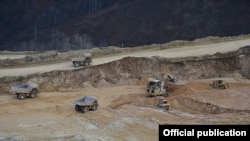For the first time since the mid-1990s, Russia surpassed the European Union as Armenia’s number one trading partner in the first half of this year, official Armenian statistics show.
The National Statistical Service (NSS) reported this month that Russia accounted for 26.4 percent of Armenia’s foreign trade in that period, compared with the EU’s 25.3 percent share in the total.
The NSS said that Russian-Armenian trade grew by 12.4 percent to almost $600 million on the back of a near doubling of Armenian exports to Russia. Armenia’s first-half trade with EU member states was up by less than 2 percent.
The EU became Armenia’s largest trading partner just a few years after the break-up of the Soviet Union. It has since been the South Caucasus country’s main supplier of industrial equipment, cars and some consumer goods. Europe has also been the principal destination of key Armenian export items such as base metals and refined diamonds.
By the late 1990s, the EU was already generating roughly one-third of Armenia’s commercial exchange with the outside world. NSS figures show that this proportion remained largely unchanged in the following decade.
By contrast, Russia’s share in Armenian foreign trade steadily declined, standing at only 11.5 percent in 2004.
These trade patterns began slowly changing in 2012 amid rising Armenian food exports to Russia and falling international prices of copper and other non-ferrous metals, the single biggest source of Armenia’s export revenue. President Serzh Sarkisian’s controversial decision in 2013 to make his country part of a Russian-led trade bloc, instead of signing a far-reaching free-trade deal with the EU, appears to have only accelerated that trend.
Russia’s commercial significance to Armenia kept increasing even after a sharp depreciation of the Russian ruble caused trade between the two countries to shrink by 18 percent last year. A fall in Armenia’s trade with the EU was even steeper.
According to the NSS, EU exports to Armenia collapsed by more than 30 percent in 2015, reflecting decreased consumer spending in the country, which was in turn caused, in large measure, by falling remittances from Armenians working in recession-hit Russia.
As the ruble rallied against the U.S. dollar in the first half of 2016 Armenian exports to Russia soared by almost 90 percent to $168 million. Alcoholic beverages, prepared foodstuffs and fresh agricultural products made up the bulk of those shipments.
Russia has traditionally been the main export market for Armenia’s food-processing and agricultural sectors. Armenia’s membership in the Eurasian Economic Union (EEU) has clearly further facilitated their access to that vast market.
By comparison, exports of Armenian non-ferrous metals other than gold were down by more than 10 percent in January-June. Even so, Armenia’s first-half exports to the EU rose by nearly 12 percent to $230 million, meaning that the EU remains its largest export market despite falling behind Russia in the country’s overall foreign trade.






